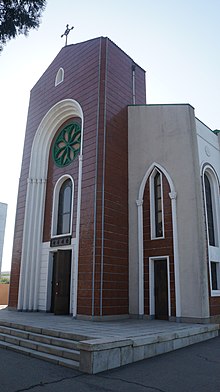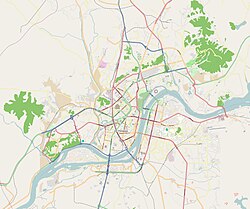Changchung Cathedral
This article includes a list of general references, but it lacks sufficient corresponding inline citations. (December 2010) |
| Changchung Cathedral | |
|---|---|
 Exterior of Changchung Cathedral | |
| Religion | |
| Affiliation | Catholic Church |
| District | Diocese of Pyongyang |
| Ecclesiastical or organizational status | Cathedral |
| Leadership | Korean Catholic Association |
| Status | No bishop |
| Location | |
| Location | Changchung, Songyo-guyok, Pyongyang, North Korea |
| Geographic coordinates | 39°00′25″N 125°46′40″E / 39.00694°N 125.77778°E |
| Architecture | |
| Completed | 1988 |
| Changchung Cathedral | |
| Chosŏn'gŭl | 장충성당 |
|---|---|
| Hancha | |
| Revised Romanization | Jangchung-seongdang |
| McCune–Reischauer | Changch'ung-sŏngdang |

Changchung Cathedral (Korean: 장충성당) is the nominal cathedral of the Roman Catholic Diocese of Pyongyang, North Korea, located in the Changchung neighborhood of Songyo-guyok, Pyongyang. It is one of only four official Christian places of worship in Pyongyang. It operates under the Korean Catholic Association.[1]
History[edit]
Before the division of Korea, Pyongyang was the city with the highest number of Christian believers in Korea, and was known as the "Korean Jerusalem".[2] By 1945, nearly 1⁄6 of its citizens were Christians. Therefore, Pyongyang was made into the only diocese in northern Korea.
After the division of Korea, however, the Communist government under Kim Il Sung persecuted Christians as imperialist collaborators and spies; even the famous Christian Nationalist Cho Man-sik, initially more influential than Kim, was arrested and shot. Much of the Catholic community was either killed or imprisoned, and many more fled south.
The original cathedral, built of red brick in the late 19th century, was destroyed in the Korean War by American forces. Earlier, in 1949, the last formal Bishop of Pyongyang, Francis Hong Yong-ho, had been imprisoned by the communist government; he later disappeared. His death was acknowledged by the Holy See in 2013, although the exact date of death is unknown.[3]
In 1988 a new cathedral was opened in East Pyongyang. At the same time, two nondenominational Protestant churches were opened in an effort by the government to show religious freedom.[4]
Operation[edit]
The cathedral is operated by the Korean Catholic Association and is not affiliated with the Holy See.[1][5] Because of the strained relations with the Holy See, the cathedral currently has no bishop or even an ordained priest.[4][2] There is no resident priest either. Masses are occasionally offered by foreign clergy when they visit Pyongyang.[1] In 2015, an agreement was reached between the Korean Catholic Association and the Catholic Bishops' Conference of Korea, allowing South Korean priests and bishops to celebrate Mass and administer the sacraments in the Cathedral on major feast days.[6]
There is a noodle factory associated with the church that receives financial support from the Roman Catholic Archdiocese of Seoul and Catholic Koreans in the United States.[1]
See also[edit]
References[edit]
- ^ a b c d Justin Corfield (2014). Historical Dictionary of Pyongyang. Anthem Press. p. 38. ISBN 978-1-78308-341-1. Archived from the original on 2017-02-16. Retrieved 2022-04-17.
- ^ a b "While pope visits the South, North Korea's 'quiet Catholics' cut off from the Vatican". Fox News. 24 March 2015. Archived from the original on 17 April 2022. Retrieved 1 November 2015.
- ^ "Cappella Papale Santa Messa In Suffragio Dei Cardinali E Vescovi Defunti Nel Corso Dell'Anno Celebrata Dal Santo Padre Francesco" (PDF). vatican.va (in Italian). 4 November 2013. Retrieved 14 December 2013.
- ^ a b "New Atheists and Old Atheists | Issue 78 | Philosophy Now". Archived from the original on 2015-06-02. Retrieved 2015-11-01.
- ^ Zwirko, Colin (9 October 2018). "Kim Jong Un says Pope welcome to visit Pyongyang: Blue House". NK News. Archived from the original on 9 October 2018. Retrieved 9 October 2018.
- ^ "Mass at N. Korean cathedral". Yonhap News Agency. 7 December 2015.
Further reading[edit]
- Foster-Carter, Aidan (2000-12-23). "Pyongyang Watch: Some of that old-time religion". Asia Times. Archived from the original on 2001-06-09.
{{cite news}}: CS1 maint: unfit URL (link)

